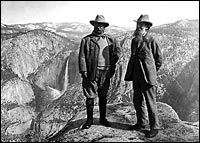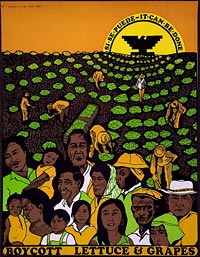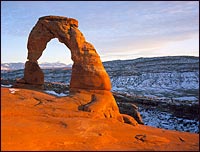
Pretty, yes, but what about the people?
Photo: National Park Service.
North Americans love their heroes, and environmentalists are no exception. The hall of fame includes some of the biggest hitters from our nation’s past: John Muir, David McTaggart, Marjory Stoneman Douglas, Paul Watson, David Brower, Rachel Carson, and Edward Abbey, to name just a few. Every Earth Day, speakers invoke these legends, yet there are also the lesser lights of the green pantheon: Alice Hamilton, the scientist who studied industrial lead poisoning and founded the modern discipline of occupational health; Crystal Eastman, the settlement-house worker who brought attention to the dilapidated housing of Pittsburgh’s working classes; and Lois Gibbs, the homemaker-turned-activist who decried the poisoning of a blue-collar suburb in upstate New York called Love Canal.
What united the latter, unsung group and others like them was a commitment to the dispossessed and the poor. In contrast, some of the most venerated conservationists and environmentalists demonstrated a decidedly misanthropic streak. Therein lies a startling and unsettling tension within the history of environmental activism.
The relationship between inequality and environmentalism is vexing. It inheres in some of North America’s most troublesome conflicts: efficiency versus equity, individual liberty versus the common good, abundance versus scarcity. Environmentalists have passionately defended things endangered or in short supply, but have rarely considered the hard truths about who benefits from saving wilderness, eliminating pollution, or halting logging and fishing. When we put a human face on the environment, the choices seem less obvious. All too often, that historical face has been poor and dispossessed.
It is an old problem. In the mid-19th century, people began to confront nature’s limits. Centuries of development had turned a seeming Eden into a wasteland of stumps and gullies. Immigration, natural reproduction, a market economy, and industrialization transformed a wilderness into commodities with astonishing rapidity. “Nor could it be imagined,” the English colonial historian Edward Johnson wrote in 1653, “that this Wilderness should turn a mart for Merchants in so short a space.”
By the time the continent came of age, the Jeffersonian ideal of the yeoman farmer, feet planted firmly in the soil of his own virtuous labor, was vanishing with the forests and fields that had sustained the myth. By 1864, George Perkins Marsh, a Vermonter who had seen the denuded farmlands of Italy, warned, “we are, even now, breaking up the floor and wainscoting and doors and window frames of our dwelling.” Marsh urged immediate action if the New World was to avoid the ruin of the Old.
The ensuing story is familiar. By the close of the 19th century, concerned citizens had stood up to stop the slaughter of the bison, stay the logger’s axe, and set aside scenic places with the help of that greatest of American inventions, the national park. Yet who were the people behind the original conservation and preservation movements? They were the upper crust, or aspirants to high status, the new middle class. And why did they fight so hard to conserve and preserve? The answers lead us into a shadow history that few environmentalists know or want to admit.
This Land Is My Land
Hunters and fishers, including some of the continent’s most powerful individuals, were among the first conservationists to seek protections for what we now call environmental amenities. The Boone and Crockett Club, for example, founded in 1887 by Theodore Roosevelt, dedicated itself to protecting game animals and their habitat — in part by taking aim at the rural poor. Roosevelt was a crack shot who championed the “fair chase” principle of hunting game with minimal equipment and an eye on the sporting experience. His generosity toward prey did not extend to people whom he and other high-class hunters deemed unsporting: poor whites and blacks who shot egrets for plumes coveted by milliners and hat-loving women. Italian immigrants who sought songbirds for food. Native peoples who caught walleye and salmon with spears and nets.

Teddy Roosevelt and John Muir stand
tall at Yosemite, 1903.
Photo: National Park Service.
William Temple Hornaday, director of the New York Zoological Park, called these marginal people the “regular army of destruction,” and hunters and fishers like him had the money and political connections to persuade state and provincial legislatures to do their bidding. In its original guise, conservation amounted to regulating hunting and fishing in ways that restricted poor people’s access to nature. States mandated the purchase of licenses, prohibited equipment favored by people who depended on wildlife for subsistence, and restricted the spaces and times of harvest. Some measures did protect imperiled fauna, but their intention and effect was also to reserve the best of nature for the best of people.
Setting aside wildlife for the worthy to consume was only one tactic that discriminated against marginalized groups. Preserving scenic places was another. The new national parks had a simple premise at their core: wilderness was a place apart from humans. Writing in 1894, John Muir described the Indians of the Yosemite as “mostly ugly, and some of them altogether hideous.” Their very presence disturbed his quest for “solemn calm” in the wilderness. They “seemed to have no right place in the landscape.” This view was widely shared among preservationists, who turned out Natives from the very places that gave them identity. Beginning with Yellowstone in 1872, officials forcefully expelled Indians, in violation of treaty obligations, to uphold the wilderness ideal.
The fixation on wilderness and wildlife also had a perverse impact on the urban poor, who — as with their rural counterparts — became victims of conservationists’ intentions. Frederick Law Olmsted, the mastermind of the modern urban park, believed that beautiful landscapes could yield responsible citizens. Olmsted viewed cities as engines of inequality. Like other reformers, he looked askance at the masses crowded into tenements and worried about the effects that living in such squalor would have upon American urban life. He designed his most famous creation, New York’s Central Park, to ameliorate the animosities of class and nationality through the healing properties of grassy lawns, shady trees, and open spaces.
Unfortunately, Olmsted’s ideas worked too well. His parks became real-estate magnets, driving up land values and compelling local residents to push for restrictions against uncouth workers and strangely clothed foreigners. Urban parks were inexorably cut off from the people Olmsted most wanted to reach through “Keep Off the Grass” signs and vagrancy laws. Some of these edicts are still enforced to keep out the homeless today.
The intersecting boundaries of race and class did more than exclude the poor and minorities from amenities. They also inspired the modern zoning laws and technological systems that made cities more habitable by driving noxious industries such as tanneries, slaughterhouses, and foundries to the physical and social margins. Modern sewage systems saved countless lives by vanquishing the sources of waterborne diseases such as cholera and typhoid, yet waste, like smelly and noisy businesses, had to go somewhere. All too often that meant poor and minority neighborhoods. Back of the Yards in Chicago, Brightside in Hamilton, Ont., the Duwamish Waterway in Seattle, and Newtown Creek in Brooklyn became sites where industry and poverty merged to create unholy toxic messes.
Well before the mid-20th century, the color line was also the green line separating those who enjoyed clean water, beautiful parks, and fresh air from those who did not. Poor lands had become the natural home for poor people. What environmentalists have not yet recognized is that the root biases of conservationist and preservationist politics remain central to the modern movement.
We Do Need Another Hero
As a distinct cultural and political phenomenon, environmentalism did not emerge until the Cold War, when North Americans living in the shadow of atomic warfare and facing rising levels of traffic and pollution began to fear the loss of the continent’s remaining open spaces. By the first Earth Day in April 1970, mainstream environmentalism had arrived in full-throated form, persuading even President Richard Nixon, eager to snatch suburban voters from the Democrats, to support the Endangered Species Act and the Environmental Protection Agency. It helped that the mainstream media had pushed the environment onto the stage through made-for-television crises such as Cleveland’s burning Cuyahoga River and flocks of oil-smeared birds along Santa Barbara beaches.

Boycotts led by Cesar Chavez began
changing the landscape.
Image: Library of Congress.
Once again, mostly white, middle-class people aligned with the movement. Only rarely did issues transcend racial and class lines. Cesar Chavez’s famous produce boycotts, launched to protect Chicano farmworkers from pesticide exposure and unsanitary conditions, was the exception that proved the rule. More typical was environmentalists’ flat-footed response to the furor over Paul Ehrlich’s The Population Bomb. The Stanford biologist, repelled by the “hellish aspect” of slums in Delhi, India, proposed limits on population, including economic sanctions and forced sterilization. Against the backdrop of the civil rights and Black Power movements, Ehrlich’s arguments read like a modern-day version of the eugenics and scientific racism supported by earlier conservationists such as Roosevelt and Hornaday (and later by writer Abbey). Although some environmentalists tried to defuse Ehrlich’s rhetoric by pointing to overconsumption in the developed world, Brower and others fanned the fires by celebrating him as a brave man who spoke unpleasant truths.
Thus environmentalism’s own troubled history contributed to the fractured political landscape we see today. In cities and among communities of color during the 1970s and 1980s, another movement emerged. While the Sierra Club focused on wilderness and endangered species, environmental-justice activists concentrated on largely urban and industrial problems such as pollution, heavy metals, toxics, unsafe food and water, illegal waste disposal, and dangerous working conditions. Meanwhile, rural residents in the western United States built a funhouse-mirror version of environmental justice. Fed up with environmentalists and government agencies, the Wise Use movement turned green rhetoric inside out, claiming that local farmers, ranchers, loggers, fishers, and miners knew best how to care for the land because they had worked it longest. When environmentalists dismissed Wise Users as dupes of corporate interests, they once again bared their ignorance of the countryside’s pent-up resentment toward meddlesome urbanites and weekend warriors.
Since the 1990s, many mainstream environmental groups have begun to reach out. The Sierra Club and the National Wildlife Federation now have staffers and programs dedicated to environmental justice. Grassroots efforts such as the Quivira Coalition in New Mexico are mending fences between ranchers and environmentalists. Yes, there have been missteps; witness the anti-immigration proposal put forward by a vocal minority in the Sierra Club, or the repeated attempts to find common cause with unionized autoworkers over fuel-efficiency standards. But the hasty alliance between unionists, civil-rights activists, and greens before the 1999 World Trade Organization meeting in Seattle suggests that something more than occasional collaboration might be possible. And it is more necessary than ever: the winds and waves that ravaged New Orleans and the Gulf Coast last August washed away any sense that race, class, and the environment do not intersect in 21st century North America.
Many scholars have tried to draw attention to the narrowness of traditional environmentalism, with mixed results. Environmental history is a fast-growing field, and most college classes on the subject are popular. Yet when historians such as William Cronon question the slavish devotion to an unattainable wilderness ideal, as he did in his 1995 essay “The Trouble with Wilderness,” most environmentalists still reflexively dismiss them as naive or dangerous. Such misguided retorts squander opportunities for honest and perhaps transformative debates at the very time we need them most.
The environmental movement has achieved great things. Without John Muir or David Brower, there would be fewer national parks and wilderness areas. Had Rachel Carson not written Silent Spring, we very well could have forgotten the warble of songbirds in the morning. David Suzuki’s tireless work has inspired millions to consider the fate of the earth their own. These and other activists deserve the hero label — but we also need to expand our notion of what constitutes nature and who speaks on its behalf. Unless environmentalists take a full reckoning of their past to find other voices to remember and celebrate, the movement may grow ever more narrow and irrelevant. Maybe, just maybe, it’s time to find some new heroes.



